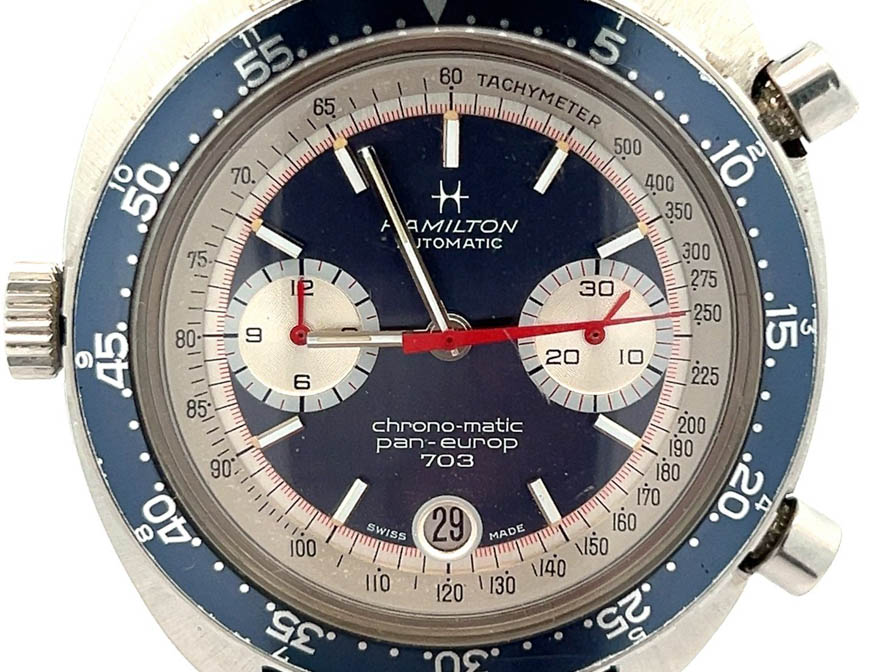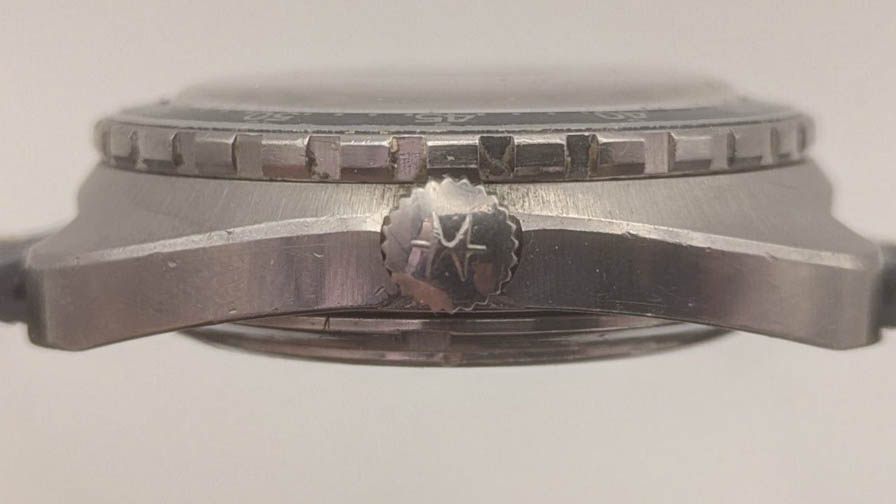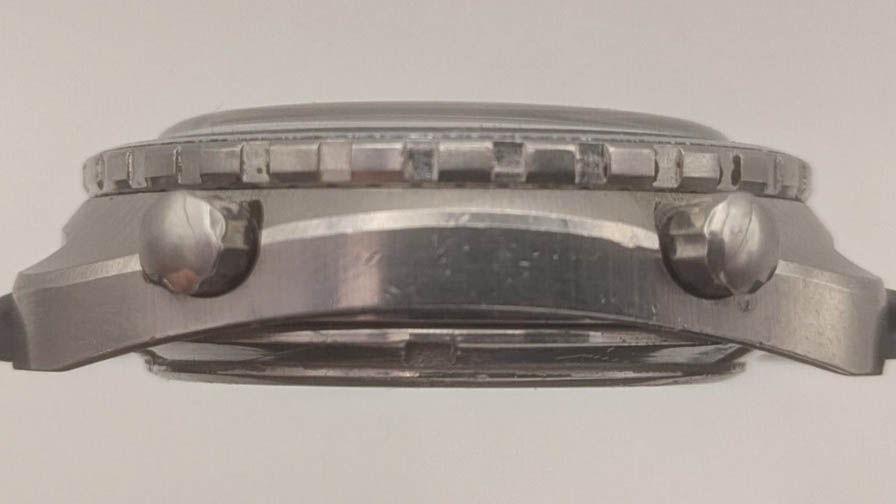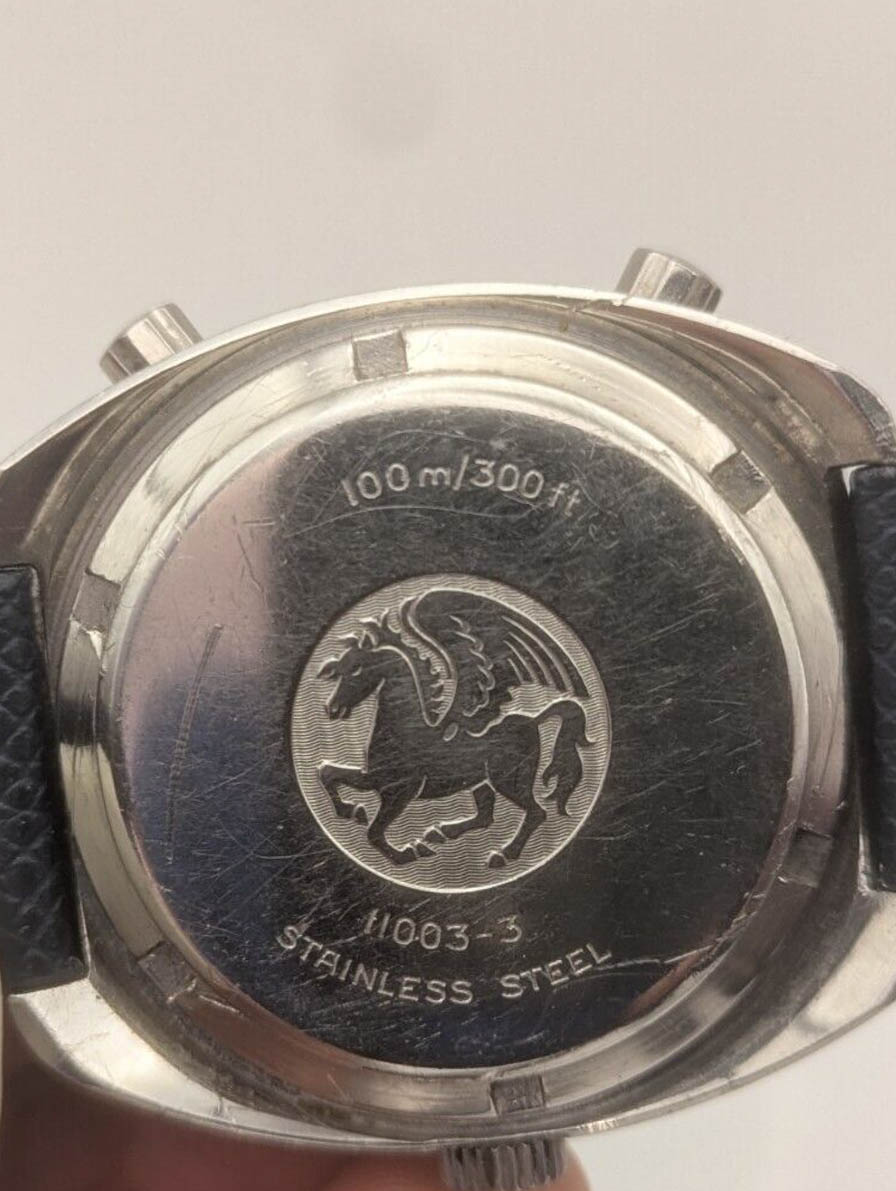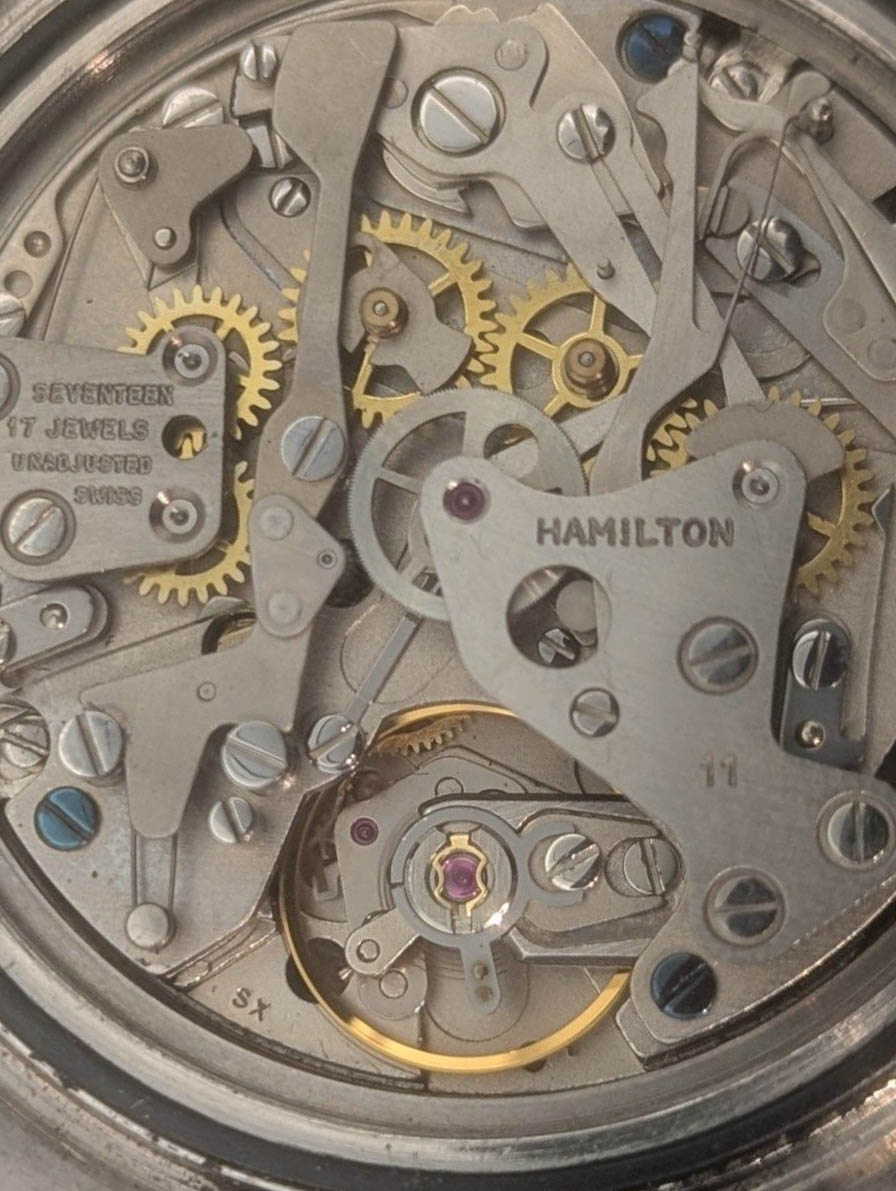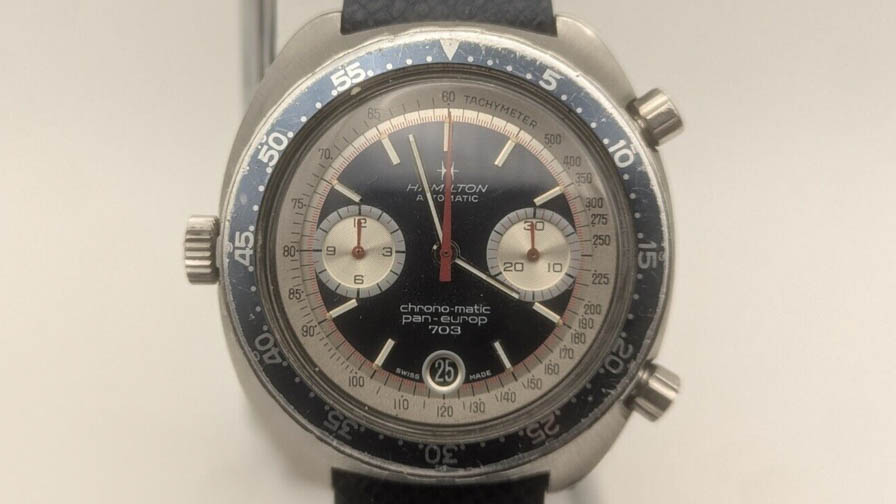The Hamilton Pan-Europ 703 is an underappreciated chapter in chronograph history. Released in 1971, this Hamilton Chrono-Matic model is powered by the now-legendary Calibre 11.
Born from the collaboration between Hamilton, Heuer, Breitling and Buren to compete against Zenith and Seiko in the race to build the first automatic chronograph watch, the result was a cushion-cased racer that embodied the spirit of 1970s motorsport. Although it had a short production run of only a few years, today it is celebrated for its technical significance, distinctive style, and pioneering spirit.
Design - 44 / 100
(Innovation and Heritage)
The Hamilton Pan-Europ Chrono-Matic 703 was the first of its kind in the Pan-Europ line, debuting a distinctive sports/diver style with the crown positioned on the left side — an unconventional choice tied directly to the Hamilton Calibre 11 movement architecture. This asymmetric layout, combined with bold 1970s proportions, gives the watch its instantly recognisable character and cements its status as a milestone in vintage Hamilton automatic chronograph design.
(Case and Bezel)
A blue 60-minute bezel surrounds the dial, paired with an inner tachymeter scale. While the crown and pushers are simply finished, their placement is ergonomic, balancing style with functionality. The brushed stainless-steel case is complemented by polished accents, giving it a sporty yet refined edge.
(Dial and Layout)
The dial achieves strong symmetry, with two chronograph sub-dials at 3 and 9 o’clock and a date at 6. Sub-dials are integrated cleanly into the design, avoiding visual clutter. Contrasting chronograph and sub-dial hands enhance legibility, while the overall design borrows cues from period diving watches and contemporary chronographs, apart from the signature left-side crown.
(Proportions and Finish)
Good balance and proportions make the watch wearable despite its size. Polished indices and hands stand out against the brushed surfaces, adding depth to the dial without excess decoration. The solid caseback is plainly finished, consistent with the tool-watch ethos.
(Options and Straps)
There were no case or dial colour variations and original dedicated straps are virtually nonexistent today. Surviving examples are typically found on period-correct steel bracelets or replaced with leather, canvas, or rubber straps from the 1970s.
Utility - 38 / 100
(Features)
The Hamilton Pan-Europ 703 delivers a balanced feature set for a 1970s sports chronograph. It combines a 30-minute chronograph and date display with dual timing functions via the 60-minute bi-directional rotating bezel and 60 – 500 inner tachymeter scale. The stainless-steel case provides the durability expected of a tool watch.
(Movement and Mechanics)
Powered by the pioneering Hamilton Calibre 11, the watch has a 42-hour power reserve. Though lacking hacking seconds and a quickset date, these compromises were typical of early first automatic chronograph watch designs. The crown on the left-hand side is unusual but comfortable in daily use.
(Legibility and Lume)
Readability is good in normal light, though the layered layout can slow quick glances. Lume on the main hands aids in low light but has typically faded with age. Bright red chronograph accents make timing functions easy to distinguish.
(Wearability and Proportions)
At 42 mm wide, 14.8 mm thick, and around 45 mm lug-to-lug, the watch offers modern wrist presence without excessive bulk. The cushion case sits securely and comfortably, and the dial layout becomes intuitive once familiar.
(Durability and Maintenance)
Originally rated to 100 m water resistance, the vintage Hamilton Pan-Europ should be considered non-water-resistant unless serviced. The acrylic crystal can scratch but is easily polished or replaced. Original case and movement parts are scarce and expensive.
(Strap and Customisation)
With 20 mm lugs, though original bracelets are rare, strap swaps are simple. Most owners opt for leather or fabric straps, which preserve wearability without impacting authenticity.
Craft - 33 / 100
(Innovation and Heritage)
The Hamilton Pan-Europ Chrono-Matic 703 is a key part of horological history, created through a Swiss–American partnership with Heuer, Breitling, and Buren. Its launch marked a milestone in the development of the Hamilton automatic chronograph segment.
(Movement and Sound)
The Hamilton Calibre 11 operates at 2.75 Hz, using a modular construction featuring a Buren micro-rotor base and a Dubois Dépraz chronograph module. While reliable with proper maintenance, servicing can be expensive and requires specialist expertise. Because of its chosen frequency, the Calibre 11 ticks differently compared to the Seiko 6139 (3 Hz), Zenith El Primero (5 Hz), other vintage chronographs (typically 2.5 Hz), or modern alternatives (4 Hz), resulting in a distinctive ticking sound.
(Casework and Finish)
The brushed and polished stainless-steel casework reflects the standards of 1970s sports watches. Polished steel hands and indices enhance clarity, while the solid screw-in caseback offers functional durability.
(Philosophy and Options)
The 703 prioritises reliability over chronometer-grade precision, in line with the tool-watch philosophy. No strap or configuration options were offered beyond the original bracelet or period-appropriate straps.
- Ref 703 11003-3 – blue dial, stainless-steel case
Value - 33 / 100
(Market Position and Stability)
Originally priced around €200 in the early 1970s (approximately €1,600 today), the Hamilton Pan-Europ Chrono-Matic (703) has grown into a collector’s piece, now trading in the €5,000–€8,000 range and above, especially for examples with papers. While not strictly a limited edition, production was short-lived, making surviving models relatively rare. Boxes and original straps are almost always missing. Condition heavily influences value. Dials, bezels, and lume often show signs of age.
(Collectability and Rarity)
Ref. 703 is sought after for its pioneering role as part of the first automatic chronograph watch race, but availability is low. Surviving examples are hard to come by and vary significantly in condition. Finding a clean, original piece requires patience. Collectors are advised to prioritise historical provenance, originality, and service documentation.
(Price / Performance)
For its cost, performance is modest compared to modern or even some contemporary chronographs. Where it lacks in outright performance, it compensates with heritage as one of the first automatic chronograph watches. Given interest in vintage Hamilton and other early 1970s sports chronographs, the Pan-Europ 703 has strong appeal.
(Competitors and Alternatives)
The Hamilton Pan-Europ should be compared against contemporary competitors as well as modern alternatives from Hamilton and other brands.
Period Competitors:
- Seiko 6139 “Pogue” – Affordable, historically important as the first automatic chronograph in space. (~€1k today)
- Zenith El Primero – High-beat 5 Hz movement, now commanding €15k–€20k.
- Breitling Chrono-Matic (Cal. 11) – Shared technology with Hamilton, valued similarly around €5k–8k.
- Heuer Monaco (Cal. 11) – Cult icon, €5k–15k depending on condition and provenance.
Modern Competitors (6k–€8k segment):
- Tudor Black Bay Chrono (€5.5k–€6k) – COSC-certified, robust, modern chronograph.
- TAG Heuer Carrera Glassbox (Heuer 02) (€6.5k–€7k) – In-house calibre, racing-style design.
- Longines Spirit Flyback (€5k–€6k) – COSC-certified flyback with strong pilot heritage.
- Omega Speedmaster Racing Co-Axial 9900 (€7.5k–€8k) – METAS-certified, modern column-wheel calibre.
Hamilton Alternatives:
- Hamilton Intra-Matic Auto Chrono (Ref. H38416711) – More affordable retro-inspired chronograph with modern movement.
- Hamilton Chrono-Matic 50 Auto Chrono (Ref. H51616731) – Bold 1970s styling with improved serviceability.
Collector Score - 37 / 100
This is a watch for collectors who see asymmetry as a sign of confidence not as a flaw. It speaks to those drawn to invention and to pieces that wear their ambition visibly. The Hamilton Pan-Europ Chrono-Matic 703 is about pushing boundaries. Ideal for those who collect with curiosity. This is a chronograph that belongs in thematically driven collections. It rewards those who appreciate overlooked icons, mechanical turning points and the kind of experience that comes with age.

